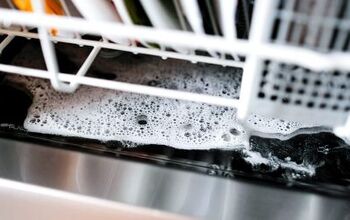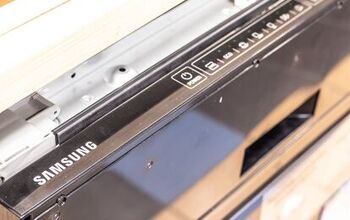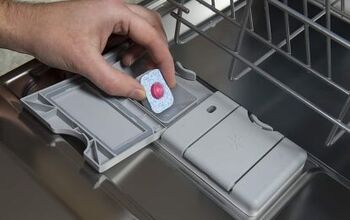Dishwasher Drain Hose Too Long? (We Have a Few Fixes)

Every component of a dishwasher is important to its function, and that’s particularly true about the drain hose. A drain hose that is too long can affect your dishwasher’s performance and it may not be able to fit correctly. So, what should you do when your dishwasher drain hose is too long?
Install an air gap 2” above the sink so that wastewater doesn’t enter the dishwasher if the drain hose is too long. You can shorten a dishwasher drain hose if you carefully cut it with a utility knife. Create a high loop that runs to the highest point beneath the sink or 32” above the kitchen floor.
A dishwasher drain hose that is too long can lead to wastewater backflow in some cases, and that can be dangerous. Always be careful when you install a dishwasher because a drain hose that is too long generally indicates a faulty installation.
Do You Need Appliance Installation or Replacement?
Get free, zero-commitment quotes from pro contractors near you.

Dishwasher Drain Hose Too Long
It likely means that you installed the dishwasher incorrectly if the drain hose is too long. However, that is not always the case, and sometimes homeowners use a drain hose that wasn’t intended for their dishwasher.
Luckily, you can simply install an air gap or create a high loop so that your drain hose will fit well even if it’s too long. Otherwise, you can cut your drain hose with a drain hose to shorten its length, but you must be precise. Let’s take a look at the best solutions for a dishwasher drain hose that is too long.
Air Gap
A dishwasher air gap is a fitting affixed roughly two inches above your kitchen sink. Its primary purpose is to prevent contaminated wastewater from entering into the dishwasher from the drain through backflow. Installing an air gap is a simple solution to ensure that wastewater and potential contaminants do no re-enter your clean water supply.
When you are running your dishwasher through a cycle, the last thing you want is for your dishes to come out covered in grime from your clogged garbage disposal. The air gap will completely separate the hose depositing dirty water from the hose that is running to the drain. With this, the two pathways will never connect, and there is no risk of wastewater seeping back into your appliance.
If you suspect that your dishwasher drain hose may be too long, it will likely benefit from installing an air gap.
How Does an Air Gap Work?
When you install an air gap on your dishwasher it physically separates two branches of hose with air to guarantee that cross-contamination between the drain and dishwasher does not occur. One branch of this air gap fittin g is attached from the dishwasher to the air gap, while the other goes from the air gap down to the garbage disposal attachment.
The dishwasher drain hose comes out of the dishwasher and curves upward. At its highest point, the branch ends and water exits the open end of the tube, goes through the air gap, and escapes into the second branch. The second branch is what carries the wastewater to the designated drainage location. These two branches are installed beneath your countertop or sink and the fittings extend above the counter.
Do I Need an Air Gap?
Air gaps are the most effective way to prevent your drain from cross-contaminating your dishwasher with wastewater. If you want to safeguard your dishwasher against flooding with polluted water, you need some form of backflow prevention. Although air gaps are not the only option, they may be required by plumbing code in some areas.
Also, while other backflow prevention methods can dissuade cross-contamination, an air gap is the only technique that guarantees protection against wastewater escaping into your appliances. In fact, most plumbing codes across the United States require commercial food and beverage prep sinks to possess an air gap. Whereas, states such as Minnesota, California, Hawaii, and Washington require dishwasher air gaps residentially.
Consider installing an air gap to both ensure that your home is up to code and correct any issues with your dishwasher drain hose being “too long.”
How to Install an Air Gap
- Look under your counter for the air gap hole. Most counters will have a hole precut for this exact purpose. If the opening does not already contain an air gap, it may be covered by a flat disc-like concealment. Drill an air gap hole before you proceed if there isn’t one already. Use an electric drill and hole saw to cut a 1-3/8” hole in your countertop. Make sure that the hole is close enough to the edge of the sink so that the air gap will have enough room to drain should the tubes overflow.
- Once you’ve located your air gap hole, connect the air gap to the dishwasher drain hose. The drain hose will connect to the small side of the air gap. Affix the 5/8” tube to the 5/8” end of the air gap. Then, tightly fasten the tube using stainless steel hose clamps.
- Connect the air gap to the garbage disposal or drain hose. Next, you’ll want to measure and cut a piece of 7/8” tubing to attach the air gap to the disposal. Affix the tube to the Y-branch tailpiece that connects the drain to the sink and fasten with a hose clamp. Attach the 7/8” tube to the disposal and fasten with a hose clamp.
- Press the air gap out of the hole on the counter. First, take off the vanity covering on the heading of the air gap and place it into your counter hole from below. Tightly secure the air gap against the counter by threading a nut alongside the air gap’s threads. When you’ve threaded the nut manually and stabilized the air gap, use a wrench to ensure that the air gap is fastened securely to the counter.
- Test your dishwasher. Run a full cycle of dishes to test if the air gap and dishwasher work properly.
High Loop
Your other option if you suspect that your dishwasher drain hose is too long is to loop the drain line higher than the connection to the disposal, or designated drainage site. Otherwise known as the high loop method, this backflow prevention technique involves running the drain line from the dishwasher to the highest point underneath the sink. The loop is fastened beneath the counter using a bracket and drains down into the garbage disposal or sink drain.
The physics behind the high loop is that the drained water from the dishwasher is forced to travel up before it can escape out the drain. For best results, high loops should be at least 32” above the floor of your kitchen. If you do not have a clearance of at least 32” between the peak of the high loop and the ground, you will need to install an air gap instead.
With a high loop, the tubing is installed at such a drastic slope. As a result, the wastewater is very unlikely to backflow when the high loop is properly installed. Although the high loop method is classic and effective to prevent backflow, it is not as foolproof as an air gap. However, it will certainly do the trick if you are concerned about the length of your dishwasher drain hose.
Do You Need Appliance Installation or Replacement?
Get free, zero-commitment quotes from pro contractors near you.

Can I Shorten My Dishwasher Drain Hose?
You can shorten your dishwasher drain hose if you measure and cut it with a utility knife. Measure carefully so you don’t cut too much off of the drain hose or it won’t connect. The drain hose must reach the tailpiece or it won’t be able to drain water from the dishwasher.
Wrapping It Up
You likely did not install the dishwasher properly if the drain hose is too long. High loops are common, inexpensive to install, and have proven to be successful at backflow prevention. It will get your dishwasher drain hose off of the floor and mediate your worries about it being too long. On the other hand, if you don’t have enough clearance under your counter, you can opt for the more reliable air gap solution.
Related Guides

Jessica considers herself a home improvement and design enthusiast. She grew up surrounded by constant home improvement projects and owes most of what she knows to helping her dad renovate her childhood home. Being a Los Angeles resident, Jessica spends a lot of her time looking for her next DIY project and sharing her love for home design.
More by Jessica Stone



























